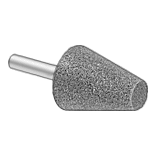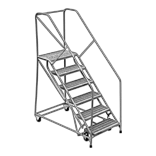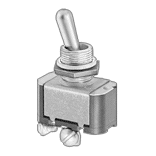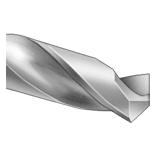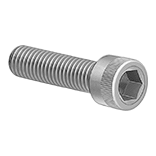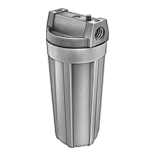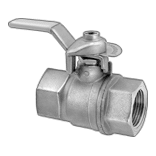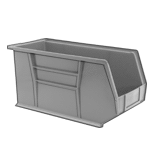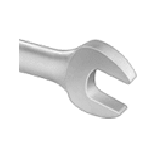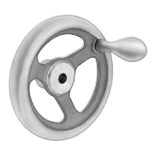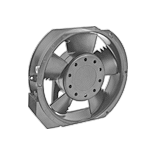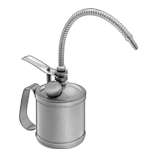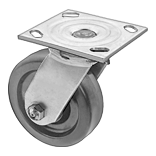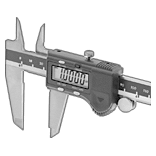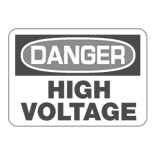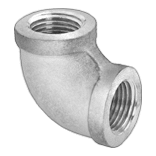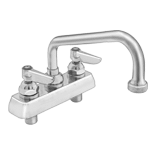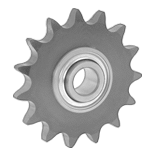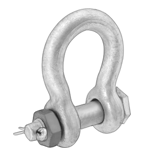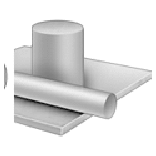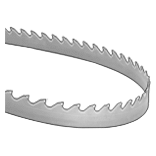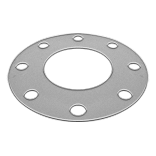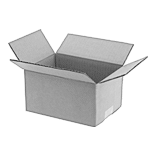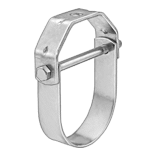Compression Springs
As you squeeze a compression spring, it pushes back to return to its original length. Spring rate is the amount of force required for every inch of compression or, for metric springs, millimeter of compression. The higher the spring rate, the harder it is to compress the spring.
Chrome-silicon steel springs have a high tensile strength for reliable operation over a long lifetime.
Springs with closed and ground ends sit flat, so they won’t buckle.
For technical drawings and 3-D models, click on a part number.
Wire | ||||||||||
|---|---|---|---|---|---|---|---|---|---|---|
| OD | ID | Dia. | Compressed Lg. @ Max. Load | Max. Load, lbs. | Spring Rate, lbs./in. | Material | End Type | Pkg. Qty. | Pkg. | |
10" Lg. | ||||||||||
| 2.906" | 2.344" | 0.281" | 3.864" | 247 | 42 | Spring-Tempered Steel | Closed and Ground | 1 | 000000000 | 000000 |
| 3.156" | 2.156" | 0.5" | 6.625" | 1,366.1 | 426.2 | Spring-Tempered Steel | Closed and Ground | 1 | 000000000 | 00000 |
| 3.156" | 2.28" | 0.438" | 5.681" | 968.05 | 237.1 | Spring-Tempered Steel | Closed and Ground | 1 | 000000000 | 00000 |
| 4" | 2.75" | 0.625" | 7.3" | 2,198 | 815 | Chrome-Silicon Steel | Closed and Ground | 1 | 0000000 | 000000 |
Compression Spring Stock
Keep these extra-long springs on hand so you can cut the right length whenever you need it.
As you squeeze a compression spring, it pushes back to return to its original length. Spring rate is the amount of force required for every inch of compression. The higher the spring rate, the harder it is to compress the spring.
To determine the spring rate of a cut spring, first multiply the spring’s original length by the spring rate given, then divide the result by the cut length (in inches).
For technical drawings and 3-D models, click on a part number.
Extension Springs with Loop Ends
As you stretch an extension spring, it gets harder to pull. Minimum load is the amount of force required to start to extend the spring. Maximum load is the amount of force required to fully extend the spring. Spring rate is the amount of force required for every inch or millimeter of extension.
For technical drawings and 3-D models, click on a part number.
Load, lbs. | |||||||||
|---|---|---|---|---|---|---|---|---|---|
| OD | Wire Dia. | Extended Lg. @ Max. Load | Min. | Max. | Spring Rate, lbs./in. | Material | Pkg. Qty. | Pkg. | |
10" Lg. | |||||||||
| 0.625" | 0.072" | 13" | 3.4 | 8.8 | 1.8 | Music-Wire Steel | 3 | 00000000 | 000000 |
| 1.125" | 0.148" | 12.28" | 23.24 | 53.78 | 13.41 | Spring-Tempered Steel | 1 | 0000000 | 0000 |
| 2" | 0.177" | 22.73" | 8.37 | 92.95 | 6.6 | Music-Wire Steel | 1 | 0000000 | 00000 |
| 2" | 0.207" | 18.66" | 12.88 | 143.12 | 15 | Music-Wire Steel | 1 | 00000000 | 00000 |
Corrosion-Resistant Extension Springs with Loop Ends
Made of stainless steel, these springs are more corrosion resistant than steel springs. They're also easier to extend than steel springs. As you stretch an extension spring, it gets harder to pull. Minimum load is the amount of force required to start to extend the spring. Maximum load is the amount of force required to fully extend the spring. Spring rate is the amount of force required for every inch or millimeter of extension.
302 stainless steel springs have good corrosion resistance.
316 stainless steel springs have excellent corrosion resistance.
For technical drawings and 3-D models, click on a part number.
Load, lbs. | |||||||||
|---|---|---|---|---|---|---|---|---|---|
| OD | Wire Dia. | Extended Lg. @ Max. Load | Min. | Max. | Spring Rate, lbs./in. | Material | Pkg. Qty. | Pkg. | |
10" Lg. | |||||||||
| 1.125" | 0.148" | 13.86" | 23.24 | 68.3 | 11.66 | 302 Stainless Steel | 1 | 000000000 | 000000 |
| 2" | 0.177" | 22.73" | 6.97 | 77.43 | 5.498 | 302 Stainless Steel | 1 | 00000000 | 00000 |
| 2" | 0.207" | 14" | 10.73 | 60.75 | 12.495 | 316 Stainless Steel | 1 | 00000000 | 00000 |
| 2" | 0.207" | 18.66" | 10.73 | 119.22 | 12.495 | 302 Stainless Steel | 1 | 00000000 | 00000 |
Extension Springs with Hook Ends

As you stretch an extension spring, it gets harder to pull. Minimum load is the amount of force required to start to extend the spring. Maximum load is the amount of force required to fully extend the spring. Spring rate is the amount of force required for every inch or mm of extension.
For technical drawings and 3-D models, click on a part number.
Corrosion-Resistant Extension Springs with Hook Ends

Made of stainless steel, these springs are more corrosion resistant than steel springs. They're also easier to extend than steel springs. As you stretch an extension spring, it gets harder to pull. Minimum load is the amount of force required to start to extend the spring. Maximum load is the amount of force required to fully extend the spring. Spring rate is the amount of force required for every inch or millimeter of extension.
302 stainless steel springs have good corrosion resistance.
For technical drawings and 3-D models, click on a part number.
Extension Springs with Special Ends

For specialty applications and connections, these springs have unique end types.
As you stretch an extension spring, it gets harder to pull. Minimum load is the amount of force required to start to extend the spring. Maximum load is the amount of force required to fully extend the spring. Spring rate is the amount of force required for every inch of extension.
All zinc-plated steel springs have mild corrosion resistance.
302 stainless steel springs have good corrosion resistance.
For technical drawings and 3-D models, click on a part number.
Load, lbs. | |||||||||||
|---|---|---|---|---|---|---|---|---|---|---|---|
| Style | Lg. | OD | Wire Dia. | Extended Lg. @ Max. Load | Min. | Max. | Spring Rate, lbs./in. | Material | Pkg. Qty. | Pkg. | |
Double Loop | |||||||||||
| B | 10" | 0.5" | 0.063" | 16.599" | 3.26 | 13.96 | 1.621 | 302 Stainless Steel | 2 | 0000000 | 000000 |
| B | 10" | 0.5" | 0.063" | 16.599" | 3.84 | 15.58 | 1.78 | Music-Wire Steel | 2 | 00000000 | 00000 |
| B | 10" | 0.5" | 0.063" | 16.78" | 3.52 | 15.58 | 1.78 | Zinc-Plated Spring-Tempered Steel | 3 | 0000000 | 00000 |
| B | 10" | 0.625" | 0.072" | 18.649" | 4.33 | 18.16 | 1.598 | 302 Stainless Steel | 2 | 0000000 | 00000 |
| B | 10" | 0.625" | 0.072" | 18.649" | 5.1 | 21.1 | 1.85 | Music-Wire Steel | 2 | 00000000 | 00000 |
Die Springs
Use these spring-tempered steel die springs for low-cycle applications such as trimming and stamping. All have closed and ground ends, which provide a flat mounting surface for even movement and distribution of loads.
Deflection is the distance the spring compresses, expressed as a percentage of its length.
As you squeeze a die spring, it gets harder to push. Spring rate is the amount of force required for every inch of compression. The higher the spring rate, the harder it is to compress the spring.
For technical drawings and 3-D models, click on a part number.
Wire | |||||||||||
|---|---|---|---|---|---|---|---|---|---|---|---|
| Lg. | Thick. | Wd. | Compressed Lg. @ Max. Load | Deflection @ Max. Load | Max. Load, lbs. | Spring Rate, lbs./in. | Material | Color | End Type | Each | |
For 1 1/4" Hole Dia. (For 5/8" Shaft Dia.) | |||||||||||
| 10" | 0.156" | 0.281" | 8.5" | 25% | 420 | 168 | Spring-Tempered Steel | Black | Closed and Ground | 0000000 | 000000 |
For 1 1/2" Hole Dia. (For 3/4" Shaft Dia.) | |||||||||||
| 10" | 0.188" | 0.313" | 8.5" | 25% | 500 | 200 | Spring-Tempered Steel | Black | Closed and Ground | 0000000 | 00000 |
For 1 3/4" Hole Dia. (For 7/8" Shaft Dia.) | |||||||||||
| 10" | 0.188" | 0.375" | 8.5" | 25% | 580 | 232 | Spring-Tempered Steel | Black | Closed and Ground | 0000000 | 00000 |
For 2" Hole Dia. (For 1" Shaft Dia.) | |||||||||||
| 10" | 0.219" | 0.438" | 8.5" | 25% | 820 | 328 | Spring-Tempered Steel | Black | Closed and Ground | 0000000 | 00000 |
